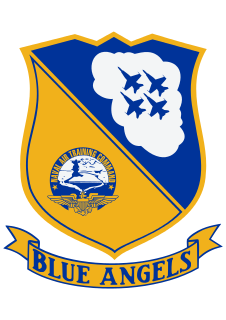
The Blue Angels is a flight demonstration squadron of the United States Navy. Formed in 1946, the unit is the second oldest formal aerobatic team in the world, after the French Patrouille de France formed in 1931. The team, composed of five Navy and one Marine Corps demonstration pilot, fly Boeing F/A-18 Super Hornets.

Joseph Jacob Foss was a United States Marine Corps major and a leading Marine fighter ace in World War II. He received the Medal of Honor in recognition of his role in air combat during the Guadalcanal Campaign. In postwar years, he was an Air National Guard brigadier general, served as the 20th Governor of South Dakota (1955–1959), president of the National Rifle Association (NRA) and the first commissioner of the American Football League. He also was a television broadcaster.

Gregory "Pappy" Boyington was an American combat pilot who was a United States Marine Corps fighter ace during World War II. He received the Medal of Honor and the Navy Cross. A Marine aviator with the Pacific fleet in 1941, Boyington joined the "Flying Tigers" of the Republic of China Air Force and saw combat in Burma in late 1941 and 1942 during the military conflict between China and Japan.
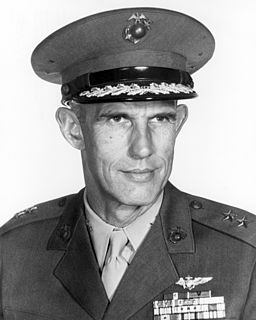
Major General Marion Eugene Carl was a World War II fighter ace, record-setting test pilot, and Naval Aviator. He was the United States Marine Corps' first ace in World War II.

Alexander Vraciu was a United States Navy fighter ace, Navy Cross recipient, and Medal of Honor nominee during World War II. At the end of the war, Vraciu ranked fourth among the U.S. Navy's flying aces, with 19 enemy planes downed during flight and 21 destroyed on the ground. After the war, he served as a test pilot and was instrumental in forming the post-war Naval and Marine Air Reserve program. From 1956 to 1958 Vraciu led his own fighter squadron, VF-51, for twenty-two months. He retired from the U.S. Navy with the rank of commander on December 31, 1963. Vraciu later moved to Danville, California, and worked for Wells Fargo.

Jefferson Joseph DeBlanc was an American World War II Marine Corps fighter pilot and flying ace, credited with shooting down nine Japanese aircraft during two tours of duty in the Pacific at Guadalcanal and Okinawa. On January 31, 1943, despite mechanical problems with his aircraft, he pressed forward with a mission and shot down five Japanese aircraft in minutes before being shot down himself. DeBlanc parachuted to safety and was rescued by native islanders, traded for a sack of rice, and picked up by a Navy seaplane. He received the Medal of Honor for his actions that day. He served in the Marine Corps Reserve until 1972. In that time, he also taught school and completed graduate and doctoral degrees in math, physics and education.

Kenneth Ambrose Walsh was a United States Marine Corps lieutenant colonel and a Medal of Honor recipient who was the fourth ranking USMC fighter ace in World War II with a record of 21 enemy planes destroyed. He also served in Korea during the first year of the Korean War and retired from the Marine Corps in February 1962.
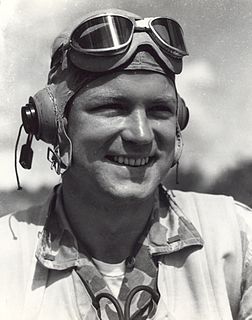
Robert Murray Hanson was a United States Marine Corps flying ace who shot down 25 Japanese planes from the South Pacific skies. He posthumously received the Medal of Honor. One of five children, he is the elder brother of Edith Hanson and Earl Dorchester Hanson.
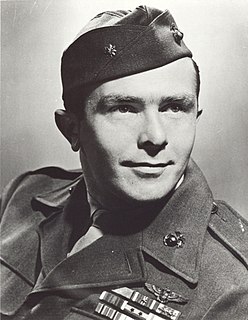
James Elms Swett was a United States Marine Corps fighter pilot and flying ace during World War II. He was awarded the United States' highest military decoration, the Medal of Honor, for actions while a division flight leader in VMF-221 over Guadalcanal on April 7, 1943. He downed a total of 15.5 enemy aircraft during the war, earning two Distinguished Flying Crosses and five Air Medals.

Lieutenant CommanderJunichi Sasai was a Japanese naval aviator and fighter ace of the Imperial Japanese Navy during World War II. Lieutenant (j.g.) (中尉) Sasai was killed leading his fighter squadron during an attack on Henderson Field during the Battle of Guadalcanal.

Dogfights is a military aviation themed TV series depicting historical re-enactments of air-to-air combat that took place in World War I, World War II, the Korean War, and the Vietnam War, as well as smaller conflicts such as the Gulf War and the Six-Day War. The program consists of former fighter pilots sharing their stories of actual dogfights in which they took part, combined with computer-generated imagery (CGI) to give the viewer a better perspective of what it is like to engage in aerial combat. Dogfights originally aired on the History Channel from November 2006 to May 2008. Repeats of the series are currently airing on the digital broadcast network Quest.
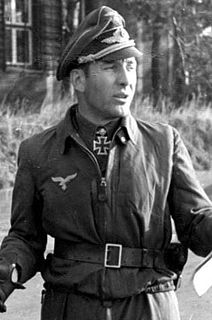
Theodor Weissenberger was a German Luftwaffe military aviator during World War II and a fighter ace credited with 208 enemy aircraft shot down in 375 combat missions. The majority of his victories were claimed near the Arctic Ocean in the northern sector of the Eastern Front, but he also claimed 33 victories over the Western Front. He claimed eight of these victories over the Western Allies while flying the Messerschmitt Me 262 jet fighter.
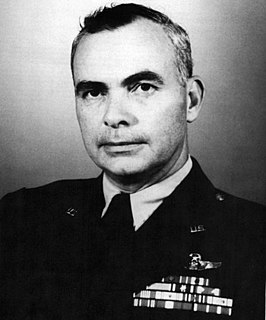
Colonel Charles Henry "Mac" MacDonald was a United States Air Force officer and a fighter ace of World War II. MacDonald commanded the 475th Fighter Group for 20 months in his P-38 Lightning, "Putt Putt Maru", and become the third ranking fighter ace in the Pacific during World War II.

John Franklin Bolt was a naval aviator in the United States Marine Corps and a decorated flying ace who served during World War II and the Korean War. He remains the only U.S. Marine to achieve ace status in two wars and was also the only Marine jet fighter ace. He rose to the rank of lieutenant colonel during his military career.

Aerial ramming or air ramming is the ramming of one aircraft with another. It is a last-ditch tactic in air combat, sometimes used when all else has failed. Long before the invention of aircraft, ramming tactics in naval warfare and ground warfare were common. The first aerial ramming was performed by Pyotr Nesterov in 1914 during the First World War. In the early stages of World War II the tactic was employed by Soviet pilots, who called it taran, the Russian word for "battering ram".

James Philo Hagerstrom was a fighter ace of both the United States Army Air Forces (USAAF) in World War II and the U.S. Air Force (USAF) in the Korean War. With a career total of 14.5 victories, he is one of seven American pilots to have achieved ace status in two different wars.

Captain Cecil Elwood "Cece" Harris was an American schoolteacher, naval aviator and flying ace of World War II. Harris is remembered for actions in the Pacific Ocean Theater, which earned him nine combat medals including the Navy Cross, the highest award for valor after the Medal of Honor. He ended the war as the navy's second-highest-scoring ace after David McCampbell (34), credited with shooting down 24 Japanese planes. Harris scored 16 of his aerial victories in four different days, downing four enemy aircraft on each of those days. Never during the course of his 88-day tour with VF-18 did a bullet hit his aircraft. It has been said that Harris "was arguably the most consistently exceptional fighter pilot in the US Navy".
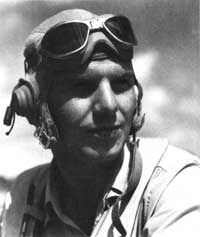
Donald Nathan Aldrich was a United States Marine Corps Reserve captain and World War II flying ace. With 20 victories, Aldrich was the fifth-highest-scoring Marine Corps ace of the war. He joined the Royal Canadian Air Force after the United States Army Air Corps refused him because he was married. Aldrich became an instructor pilot and transferred to the United States Marine Corps in late 1942. He joined VMF-215 in the Solomon Islands campaign in June 1943, flying the Vought F4U Corsair. Aldrich added to his 20 victories in three combat tours with six probables, the highest total number of probables in the Marine Corps. Postwar, Aldrich continued to serve in the Marine Corps and was killed in a 1947 plane crash.
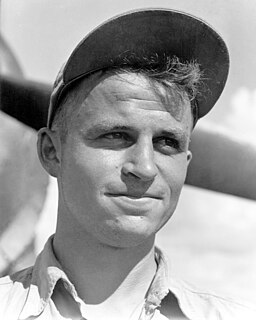
Edward Oliver Shaw was a Marine Corps flying ace during World War II, credited with taking out 13 enemy aircraft. He was awarded the Distinguished Flying Cross and reached the rank of captain before he was killed during a test flight in California.
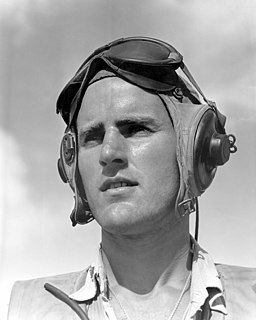
Jack Eugene Conger was a highly decorated United States Marine Corps officer. He was a flying ace credited with shooting down 10 enemy aircraft and was awarded the Navy Cross during World War II.




















